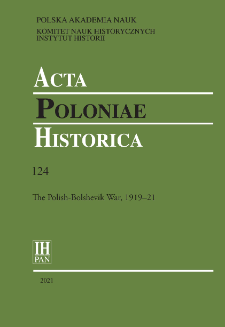
Obiekt
Tytuł: Polish-Soviet War in Film and Cinema: A New Perspective Based on the Films For You, O Poland (1920) and Miracle on the Vistula (1921)
Inny tytuł:
Acta Poloniae Historica T. 124 (2021) ; The Polish-Bolshevik War, 1919-21
Twórca instytucjonalny:
Polska Akademia Nauk. Komitet Nauk Historycznych
;
Polska Akademia Nauk, Instytut Historii im. Tadeusza Manteuffla
![]()
Współtwórca:
Instytut Historii Polskiej Akademii Nauk
Wydawca:
Instytut Historii Polskiej Akademii Nauk
Miejsce wydania:
Opis:
Abstrakt:
The Polish-Soviet War, particularly the Battle of Warsaw (13–25 August 1920), soon became a subject of legend and myth. Irrespective of its fundamental political significance, the defeat of the Red Army was glorified as salvation for both Poland and Europe in military, ideological and metaphysical terms. Conducted beyond academia, the narrative was forged mainly by veterans, the Catholic Church and various forms of literature and art. Due to government subsidies, documentary and feature films also conveyed a normative notion of these dramatic events and their participants.This article focuses on cinematic works like Dla Ciebie, Polsko [For You, o Poland, PL 1920], and Cud nad Wisłą [The Miracle on the Vistula, PL 1921] produced in order to commemorate the war between the Poles and the Bolsheviks. Taking the iconic turn, this article scrutinises the cinematic self-portrait of the Polish nation that had already been ‘imagined’ as a bulwark of European culture in the East by earlier literary works. Spotlighting protagonists who were given a place in the pantheon of national heroes, it also asks about those who were denigrated or marginalised like women and Jews. Finally, using quantitative methods and Geographical Information System (QGIS) as a tool, the article juxtaposes the maledominated, ethnically and confessional homogeneous ‘imagined nation’ with the film entrepreneurs and actual cinema audiences characterised by their diversity.
Bibliografia:
Anderson Benedict Richard O’Gorman, Imagined Communities: Reflections on the Origin and Spread of Nationalism (London, 1991).
Bauer Ela, ‘The Jews and the Silver Screen: Poland at the End of the 1920s’, Journal of Modern Jewish Studies, xvi, 1 (2017), 80–99.
Białous Maciej, Społeczna konstrukcja filmów historycznych. Pamięć zbiorowa i polityka pamięci w kinematografii polskiej lat 1920–2010 (Białystok, 2015).
Deutsch Karl Wolfgang, Nationalism and Social Communication. An Inquiry into the Foundations of Nationality (Cambridge, MA, 1966).
Gross Natan, Film żydowski w Polsce (Kraków, 2002).
Guzek Mariusz and Zwierzchowski Piotr (eds), 1918 – kino polskie wobec odzyskania niepodległości (Bydgoszcz, 2020).
Hendrykowska Małgorzata, Historia polskiego filmu dokumentalnego (1896–1944) (Poznań, 2014).
Klenotic Jeffrey, ‘Putting Cinema History on the Map: Using GIS to Explore the Spatiality of Cinema’, in Richard Maltby, Daniël Biltereyst, and Philippe Meers (eds), Explorations in New Cinema History: Approaches and Case Studies (Malden MA, 2011), 58–84.
Lubelski Tadeusz and Stroiński Maciej (eds), Kino polskie jako kino narodowe (Kraków, 2009).
Lubelski Tadeusz, Historia kina polskiego: Twórcy, filmy, konteksty (Katowice, 2009).
Piotrowska Monika, ‘Rola i znaczenie filmu w popularyzacji historii a kształtowanie społecznej świadomości historycznej’, Zeszyty Naukowe Towarzystwa Doktorantów UJ Nauki Humanistyczne, 14 (2016), 59–78.
Pogonowska Ewa, Dzikie biesy: Wizja Rosji sowieckiej w antybolszewickiej poezji polskiej lat 1917–1932 (Lublin, 2002).
Pufelska Agnieszka, ‘Stabile Feindbilder gegen die instabile Zeit Der jüdische Bolschewismus als Propagandainstrument in der Weimarer Republik’, in Jörg Ganzenmüller, Gerd Koenen, Bernhard H. Bayerlein, Eva Oberloskamp, Karsten Brüggemann, Agnieszka Pufelska, Thomas Kroll, Hans Woller, and Julia Richers (eds), Verheißung und Bedrohung: Die Oktoberrevolution als globales Ereignis (Göttingen, 2019).
Ratajczakowa Dobrochna, ‘Cud nad Wisłą. Obrazy wojny polsko-sowieckiej 1920 roku w dramacie popularnym lat dwudziestych’, Roczniki Humanistyczne, xlii, 1 (1994), 123–36.
Witek Piotr, ‘Metafora źródła czyli film w funkcji poznawczej’, Przegląd Humanistyczny, xlvi, 1 (2002), 57–70.
Czasopismo/Seria/cykl:
Tom:
Strona pocz.:
Strona końc.:
Szczegółowy typ zasobu:
Format:
Identyfikator zasobu:
oai:rcin.org.pl:233420 ; 2450-8462 ; 0001-6829 ; 10.12775/APH.2021.124.05
Źródło:
IH PAN, sygn. A.296/124 ; IH PAN, sygn. A.295/124 Podr. ; kliknij tutaj, żeby przejść
Język:
Prawa:
Licencja Creative Commons Uznanie autorstwa-Bez utworów zależnych 4.0
Zasady wykorzystania:
Zasób chroniony prawem autorskim. [CC BY-ND 4.0 Międzynarodowe] Korzystanie dozwolone zgodnie z licencją Creative Commons Uznanie autorstwa-Bez utworów zależnych 4.0, której pełne postanowienia dostępne są pod adresem: ; -
Digitalizacja:
Instytut Historii Polskiej Akademii Nauk
Lokalizacja oryginału:
Biblioteka Instytutu Historii PAN
Dofinansowane ze środków:
Działalność upowszechniająca naukę (DUN)
Dostęp:
Kolekcje, do których przypisany jest obiekt:
- Instytut Historii PAN > Czasopisma
- Instytut Historii PAN > Wydawnictwa Instytutu
- Instytut Historii PAN > Wydawnictwa Instytutu > Czasopisma
- Instytut Historii PAN > Wydawnictwa Instytutu > Czasopisma > Acta Poloniae Historica
Data ostatniej modyfikacji:
22 wrz 2023
Data dodania obiektu:
30 sty 2022
Liczba pobrań / odtworzeń:
79
Wszystkie dostępne wersje tego obiektu:
https://rcin.org.pl/ihpan/publication/270115

 INSTYTUT ARCHEOLOGII I ETNOLOGII POLSKIEJ AKADEMII NAUK
INSTYTUT ARCHEOLOGII I ETNOLOGII POLSKIEJ AKADEMII NAUK
 INSTYTUT BADAŃ LITERACKICH POLSKIEJ AKADEMII NAUK
INSTYTUT BADAŃ LITERACKICH POLSKIEJ AKADEMII NAUK
 INSTYTUT BADAWCZY LEŚNICTWA
INSTYTUT BADAWCZY LEŚNICTWA
 INSTYTUT BIOLOGII DOŚWIADCZALNEJ IM. MARCELEGO NENCKIEGO POLSKIEJ AKADEMII NAUK
INSTYTUT BIOLOGII DOŚWIADCZALNEJ IM. MARCELEGO NENCKIEGO POLSKIEJ AKADEMII NAUK
 INSTYTUT BIOLOGII SSAKÓW POLSKIEJ AKADEMII NAUK
INSTYTUT BIOLOGII SSAKÓW POLSKIEJ AKADEMII NAUK
 INSTYTUT CHEMII FIZYCZNEJ PAN
INSTYTUT CHEMII FIZYCZNEJ PAN
 INSTYTUT CHEMII ORGANICZNEJ PAN
INSTYTUT CHEMII ORGANICZNEJ PAN
 INSTYTUT FILOZOFII I SOCJOLOGII PAN
INSTYTUT FILOZOFII I SOCJOLOGII PAN
 INSTYTUT GEOGRAFII I PRZESTRZENNEGO ZAGOSPODAROWANIA PAN
INSTYTUT GEOGRAFII I PRZESTRZENNEGO ZAGOSPODAROWANIA PAN
 INSTYTUT HISTORII im. TADEUSZA MANTEUFFLA POLSKIEJ AKADEMII NAUK
INSTYTUT HISTORII im. TADEUSZA MANTEUFFLA POLSKIEJ AKADEMII NAUK
 INSTYTUT JĘZYKA POLSKIEGO POLSKIEJ AKADEMII NAUK
INSTYTUT JĘZYKA POLSKIEGO POLSKIEJ AKADEMII NAUK
 INSTYTUT MATEMATYCZNY PAN
INSTYTUT MATEMATYCZNY PAN
 INSTYTUT MEDYCYNY DOŚWIADCZALNEJ I KLINICZNEJ IM.MIROSŁAWA MOSSAKOWSKIEGO POLSKIEJ AKADEMII NAUK
INSTYTUT MEDYCYNY DOŚWIADCZALNEJ I KLINICZNEJ IM.MIROSŁAWA MOSSAKOWSKIEGO POLSKIEJ AKADEMII NAUK
 INSTYTUT PODSTAWOWYCH PROBLEMÓW TECHNIKI PAN
INSTYTUT PODSTAWOWYCH PROBLEMÓW TECHNIKI PAN
 INSTYTUT SLAWISTYKI PAN
INSTYTUT SLAWISTYKI PAN
 SIEĆ BADAWCZA ŁUKASIEWICZ - INSTYTUT TECHNOLOGII MATERIAŁÓW ELEKTRONICZNYCH
SIEĆ BADAWCZA ŁUKASIEWICZ - INSTYTUT TECHNOLOGII MATERIAŁÓW ELEKTRONICZNYCH
 MUZEUM I INSTYTUT ZOOLOGII POLSKIEJ AKADEMII NAUK
MUZEUM I INSTYTUT ZOOLOGII POLSKIEJ AKADEMII NAUK
 INSTYTUT BADAŃ SYSTEMOWYCH PAN
INSTYTUT BADAŃ SYSTEMOWYCH PAN
 INSTYTUT BOTANIKI IM. WŁADYSŁAWA SZAFERA POLSKIEJ AKADEMII NAUK
INSTYTUT BOTANIKI IM. WŁADYSŁAWA SZAFERA POLSKIEJ AKADEMII NAUK
































